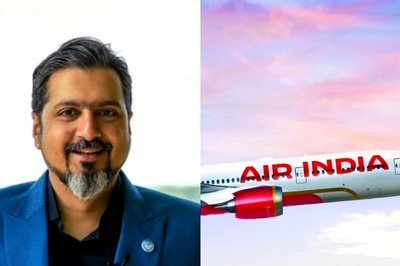
views
The first test vehicle mission of the Gaganyaan human spaceflight project will be conducted on Saturday morning (October 21) between 7 am and 9 am, the Indian Space Research Organisation (ISRO) announced on Monday.
The test flight is significant since it is the first time that the space agency has integrated a near-complete system of Gaganyaan for trial.
The test flight – TV-D01 will take off from Sriharikota at 7 am on Saturday and it’s one of the first four test vehicle missions that ISRO has planned to demonstrate all key programmes of its ambitious mission.
“The success of this test flight will set the stage for the remaining qualification tests and unmanned missions, leading to the first Gaganyaan mission with Indian astronauts onboard,” ISRO said.
WHAT IS THE ABORT MISSION?
The first development flight Test Vehicle (TV-D1) will be launched to test the first crew module (CM) that will carry Indian astronauts during the actual Gaganyaan spaceflight.
Mission Gaganyaan:ISRO to commence unmanned flight tests for the Gaganyaan mission. Preparations for the Flight Test Vehicle Abort Mission-1 (TV-D1), which demonstrates the performance of the Crew Escape System, are underway.https://t.co/HSY0qfVDEH @indiannavy #Gaganyaan pic.twitter.com/XszSDEqs7w
— ISRO (@isro) October 7, 2023
This is basically a single-stage liquid rocket developed for the abort mission. It will have two main payloads – a Crew Module (CM) and a Crew-Escape System (CEM), with fast-acting solid motors and crew module fairing and interface adaptors.
The flight will simulate the abort conditions during its ascent into the atmosphere corresponding to the speed of the final manned flight of Gaganyaan, which will be undertaken by India’s heaviest launcher – LVM Mk-3.
After its take off from Sriharikota, both the crew escape system and crew module will separate from the rocket at an altitude of about 17 km.

Once they separate, the abort sequence will be executed autonomously and deploy parachutes. If all goes well, it will culminate with the safe touchdown of the crew module in the Bay of Bengal, about 10kms from Sriharikota. A dedicated vessel and diving team of the Indian Navy will then recover it from the sea.
WHY IS IT IMPORTANT?
The first test – TV-D1 will evaluate the performance of the crew escape system and demonstrate if it is capable of safely aborting the mission as required. The Crew Module (CM) is where the astronauts will remain during the human spaceflight – it is a pressurised unit with earth-like atmospheric conditions.
However, ISRO will use an unpressurised version of the module for the upcoming flight, but its overall size and mass will be equal to the dimensions finalised for the manned flight. “The module houses all the systems for the deceleration and recovery including a complete set of parachutes, recovery aids actuation systems and pyros,” said ISRO.
Scientists have also made sure to add specific instruments to capture the flight data for further evaluation of the performance of the various systems. All the sub-systems pertaining to the test flight have been realized and the integration is completed. The crew module has undergone multiple electrical testing at ISRO’s facility in Bengaluru, including an acoustic test before it was dispatched to Satish Dhawan Space Centre, Sriharikota in August.
WHAT’S NEXT?
If TV-D1 is successful, ISRO will start preparing for TV-D2 early next year, followed by D3 as well as D4 for 2024 to test critical aspects of the mission. In addition, the team has also planned two uncrewed missions with robotic payloads – LVM3 G1 and LVM3 G2 to demonstrate the human safety of the mission before it gets go ahead for the final flight. All the sub-systems pertaining to the test flight have been realized.
WHAT IS GAGANYAAN MISSION?
India plans to send three astronauts into the Low Earth Orbit (LEO) aboard its heaviest launcher LVM Mk3. The mission will consist of a crew module which will act as living quarters for the astronauts.
The target is to position the module in a ~400 km circular orbit around earth for 1 to 3 days and bring it safely back to Earth. It will be India’s first-ever attempt at a human spaceflight programme.
Only three countries have successfully carried out human spaceflight programmes – the Soviet Union (now Russia), the United States and China. If India succeeds, it will become only the fourth country in the world to achieve the feat.
INDIA’S AMBITIOUS FUTURE
Prime Minister Narendra Modi on Tuesday chaired a high-level meeting to assess progress of India’s Gaganyaan Mission and to outline the future of India’s space exploration endeavours.
Building on the success of the Indian space initiatives, including the recent Chandrayan-3 and Aditya L1 Missions, PM Modi has directed that India should now aim for new and ambitious goals, including setting up ‘Bharatiya Antariksha Station’ (Indian Space Station) by 2035 and sending first Indian to the Moon by 2040.
The Department of Space will develop a roadmap for Moon exploration, which will include a series of Chandrayaan missions, the development of a Next Generation Launch Vehicle (NGLV), construction of a new launch pad and setting up human-centric Laboratories and associated technologies.
The prime minister also called upon scientists to work towards interplanetary missions that would include a Venus Orbiter Mission and a Mars Lander.




















Comments
0 comment